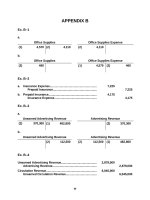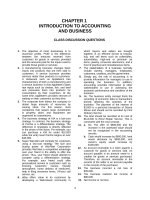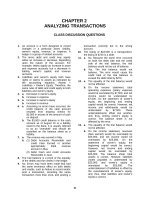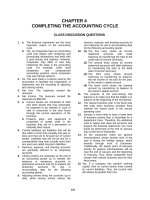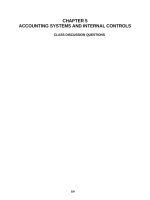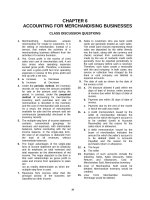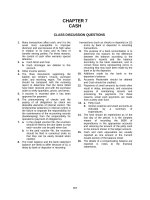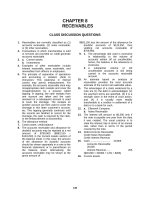Solution manual investments 10th by jones ch08
Bạn đang xem bản rút gọn của tài liệu. Xem và tải ngay bản đầy đủ của tài liệu tại đây (192.17 KB, 20 trang )
Chapter 8:
Bond Yields and Prices
CHAPTER OVERVIEW
Chapter 8 concentrates on the issues of bond yields and
prices. In effect, virtually all of the calculations concerning
bonds are contained in this chapter, thereby allowing Chapter 9
to concentrate on analysis and management issues.
The first part of Chapter 8 deals with bond yields and
begins with a discussion of interest rates because of their
obvious relationship to bond yields. After briefly considering
terminology, the chapter discusses what determines interest
rates. Important concepts such as the real rate of interest and
the Fisher hypothesis are considered here.
The important concept of yield to maturity is examined in
detail. Both conventional bonds and zero-coupon bonds are
considered. The issue of the effect of reinvestment rates on
realized returns is explained in detail. Yield-to-call and
horizon return are also discussed.
The next part of the chapter focuses on bond prices by
explaining the capitalization of income method of valuation and
then applying this methodology to the valuation of bonds.
Detailed examples are provided based on semiannual discounting.
Next, bond price changes are considered in detail. This
starts with bond price changes over time (price must converge to
face value at maturity) and then considers bond price changes as
a result of interest rate changes (Malkiel's Theorems).
A central part of this discussion is the measurement of bond
price volatility, centering on duration. This key variable is
defined and described, and all of the relationships involving
duration are illustrated. Convexity is also briefly discussed.
Instructors may wish to add to the material in this chapter,
or expand on various issues such as bond valuation, yield to
maturity, and horizon return analysis. The essential building
blocks are presented here, and additional work is possible
depending upon preferences and time constraints. This is the
minimum material that students should be exposed to, but it is
100
also a very reasonable package in terms of what beginners should
be expected to master. It allows total flexibility for
instructors to add to this material with their own examples,
problems, calculations, and so forth.
CHAPTER OBJECTIVES
To consider the determination of market interest rates as a
natural complement to the discussion of bond yields.
To analyze important calculations such as yield to maturity,
yield to call, and realized compound yield.
To explain the concept of valuation (capitalization of
income) and apply it specifically to bonds.
To analyze the issues involved with both prices and yields,
with particular emphasis on calculations.
101
MAJOR CHAPTER HEADINGS [Contents]
Bond Yields
[bond yields and interest rates are the same concept]
The Basic Components of Interest Rates
[real rate of interest; Fisher hypothesis]
Measuring Bond Yields
[current yield; yield to maturity; yield to call; realized
compound yield; reinvestment risk; interest-on-interest;
calculations; examples for both coupon bonds and zero-coupon
bonds; horizon return]
Bond Prices
The Valuation Principle
[the calculation of intrinsic value using discounted cash
flow analysis]
Bond Valuation
[calculating bond prices using semiannual discounting;
required yield]
Bond Price Changes
Bond Price Changes Over Time
[price must converge to face value by maturity date]
Bond Price Changes As a Result of Interest Rate Changes
[explanations and illustrations of Malkiel’s bond theorems;
the implications of Malkiel’s theorems to investors--coupon
and maturity are key factors, given a change in rates]
Measuring Bond Price Volatility: Duration
[definition; calculation; understanding duration; measuring
price changes using duration; examples of all calculations;
convexity explanation, with diagram; some conclusions on
duration]
102
Appendix 8-A
Convertible Bonds
POINTS TO NOTE ABOUT CHAPTER 8
Tables and Figures
Table 8-1 illustrates the calculation of realized yield
based on varying reinvestment rates. This analysis is useful to
emphasize in order for students to really understand interest-oninterest and related concepts such as the yield to maturity and
the realized compound yield.
Table 8-2 is of interest in showing bond price calculations.
It illustrates the inverse relationship between prices and yields
for varying time periods.
Table 8-3 is an example of calculating the duration of a
bond.
Figure 8-1 is a simple illustration
prices must converge by maturity date to
other things equal, a discount bond must
premium bond must decline in price, both
maturity date.
of the fact that bond
the face value. Thus,
rise in price while a
moving to $1,000 by
Figure 8-2 illustrates the convex relationship between
yields and prices. Instructors may choose to explain this
concept in a basic manner in a beginning course, but it probably
is not necessary, or desirable, to elaborate on it in too much
detail.
Figure 8-3 illustrates the cash flow pattern of a couponpaying bond as an aid in understanding the difference between a
bond's maturity and its duration.
Figure 8-4 illustrates the convex relationship between
yields and prices as an aid in understanding the convexity
principle.
103
Box Inserts
Box 8-1 illustrates how duration is used to manage actual
bond portfolios. It defines duration, explains how investors can
use it, and shows how some particular mutual fund managers
actually do use it in managing their bond portfolios.
104
ANSWERS TO END-OF-CHAPTER QUESTIONS
8-1.
Yield to maturity (YTM) is defined as the indicated
(promised) compounded rate of return an investor will
receive from a bond purchased at the current market price
and held to maturity.
Two methods of determining YTM are:*
(a)
(b)
bond tables
solving the equation for YTM using a calculator or
software
*We ignore the approximation formula because there is
little or no justification for using it in today's world
of computers and calculators.
8-2.
It is YTM that equilibrates in the marketplace, and bond
prices change to reflect this equilibration. Investors
invest on the basis of promised yields (i.e., YTMs),
reflecting current conditions in the marketplace. Bond
prices must adjust to these new conditions as reflected
in new YTMs.
8-3.
To say that YTM is an expected yield is to say that if we
purchase the bond today at its current market price and
hold it to maturity (and the issuer does not default),
and if we reinvest the coupons at the indicated YTM rate,
we can expect to earn the stated YTM. Obviously, the
rate is promised--it may not materialize. If the
conditions outlined do not occur, the actual yield will
differ from the expected yield.
8-4.
Investors buy bonds, like any other asset, on the basis
of their expected future performance. Therefore, they
must consider measures of the promised return. We use
the realized compound yield to calculate what we actually
earned, but we must make estimates of what we expect to
earn when we purchase an asset.
8-5.
Interest on interest refers to the fact that investment
in a bond generates coupon (interest) income which in
turn is reinvested to earn additional interest.
Therefore, we are earning interest on interest already
105
earned. It is part of the compounding process inherent
in the nature of bond calculations.
8-6.
Bond A will be more affected because of the higher
coupon.
8-7.
Promised yield (YTM) is exactly that--what an investor
expects to earn over the life of a bond purchased at the
current price and held to maturity. However, this
depends upon the rates at which the coupons are assumed
to be reinvested over time.
Realized yield indicates what has been earned on a bond
held to maturity, given a constant reinvestment rate.
Typically, because of reinvestment rate risk (intereston-interest), the realized (actual) yield will differ
from the promised yield.
8-8.
One way to eliminate reinvestment rate risk is with zero
coupon bonds. Since there are no coupons to reinvest,
there is no reinvestment rate risk. Investors know their
realized yields at time of purchase if the bond is held
to maturity (and, of course, barring default).
8-9.
The intrinsic value of any asset is usually thought of as
a present value process--the present value of the
expected cash flows from that asset. These cash flows
must be discounted at an appropriate discount rate;
therefore, intrinsic value and present value are closely
related.
8-10.
The price of a bond is determined as the present value of
its coupons and the principal repayment (ignoring zero
coupon bonds). The discount rate used is the appropriate
market yield for that issue. The present value process
for a standard bond will involve use of both a present
value term (for the principal repayment) and a present
value of the annuity term (for the coupons).
This process is relatively straightforward because the
payment dates and the amounts of coupon and principal
repayment are known at time of issuance. Furthermore, it
is relatively easy to determine the discount rate from
current market rates on similar bonds.
106
8-11.
The simple point here is that there is obviously a
difference between using annual and semiannual
discounting. The exact effects of the difference are
somewhat complex.
•
In general, if the discount rate used in the
valuation is higher than the coupon rate, annual
discounting will result in a higher present value
than will semiannual discounting (a result of a
higher present value for the principal repayment
when using annual discounting).
•
On the other hand, if the discount rate is less than
the coupon rate, semiannual discounting produces the
higher present value (a result of a higher present
value for the coupons when using semiannual
discounting).
Based on the above, we would predict that a 10%, 8 year
bond, given a discount rate of 12%, would have a higher
value using annual discounting as opposed to semiannual
discounting. Specifically,
Annual discounting
$100 (4.9676) = $496.76
$1000 (.4039) = $403.90
$900.66
8-12.
Semiannual discounting
$50 (10.1059) = $505.30
$1000 (.3936) = $393.60
$898.90
The implications of Malkiel’s bond price theorems to bond
investors concern how investors should act with regard to
trading in bonds. Specifically, the two bond variables
of major importance in assessing price changes are:
•
•
the coupon and
the maturity.
To receive the maximum impact from an expected change in
interest rates, investors should purchase low coupon,
long-maturity bonds.
8-13.
Duration accounts for the entire pattern (both size and
timing) of a bond's cash flows over its life. It tells
investors (in years) the economic lifetime of a bond,
107
whereas time to maturity focuses only on the return of
principal at the maturity date.
8-14.
•
Duration increases with time to maturity, but at a
decreasing rate, particularly beyond 15 years time
to maturity.
•
The coupon is inversely related to duration.
For a zero coupon bond, duration is equal to time to
maturity.
8-15.
This investor should choose bonds with the longest
duration. Duration is positively related to maturity and
negatively related to coupon. Since duration is
additive, a portfolio's duration is a weighted average of
each individual bond's duration.
8-16.
Duration may not be a complete measure of bond risk. It
measures volatility, which is only one aspect of the risk
in bonds. It may or may not be the best measure,
depending on the investor's perspective. If volatility
is the most important factor to an investor, duration is
probably the best measure to use.
8-17.
If the coupon rate is below the current required yield, a
bond is selling for a discount; if the coupon rate is
above, it is selling for a premium.
8-18.
The investor makes an assumption about the reinvestment
rate expected to prevail over the planned investment
horizon. The investor may also make an assumption about
the yield to maturity expected to prevail at the end of
the planned investment horizon, which in turn is used to
estimate the price of the bond at that time.
8-19.
For all coupon-paying bonds, duration is always less
than time to maturity. Duration expands with time to
maturity, but at a decreasing rate, particularly as we
get beyond 15 years. For a zero coupon bond, duration is
equal to time to maturity.
Both coupon and yield to maturity are inversely related
to duration.
108
8-20.
Convexity is the term used to refer to the degree to
which duration changes as the yield to maturity changes.
As the change in yield increases, the error that results
from using a straight line to estimate a bond's price
behavior as given by a curve increases.
Bond investors can use convexity calculations to improve
the estimate of total percentage price change referred to
in the duration discussion. Although still an
approximation, this estimate is improved over that using
only duration.
109
ANSWERS TO END-OF-CHAPTER PROBLEMS
8.1.
1.
Future date
Assumption A
6 months
1 year
$100/(1.08)
=
92.593
1.5 years
2 years
$100/(1.08)2 =
85.734
2.5 years
3 years
$100/(1.08)3 =
79.383
3
3 years
$1000/(1.08) = 793.832
$1051.54
2.
Assumption B
$50/(1.04)
= 48.077
2
50/(1.04)
= 46.228
50/(1.04)3 = 44.450
50/(1.04)4 = 42.740
50/(1.04)5 = 41.096
50/(1.04)6 = 39.516
1000/(1.04)6 = 790.315
$1052.42
Under either assumption A or B, price = $1000
(par).
Using a calculator, the discount factors can be
determined by raising the rates to the
appropriate power and taking the reciprocal.
8-2.
Assumption A
100
1
1000
P = ───[1- ───────] + ──────
.08
(1.08)3
(1.08)3
Assumption B
50
1
P = ───[1- ──────
.04
(1.04)6
1000
] + ─────
(1.04)6
P = 1250[.2062] + 793.83
P = 1250[.2097] + 790.31
P = 257.75 + 793.83 = $1051.58
P = 262.13 + 790.31
= $1052.44
8-3.
25
1
1000
P = ─── [1 - ──────── ] + ────────
.02
(1.02)12
(1.02)12
P = 1250[.2115068] + 788.4932
P = 264.38353 + 788.4932 = $1052.88
8.4.
Given the amount of the coupon and the market
interest rate, semiannual coupon payments provide a
higher price for securities selling at a premium,
but a lower price for those securities selling at a
discount. In this problem the coupon rate is 10%
and the market rate 12%; therefore, the security
will be selling at a discount, and we should expect
the price for semi-annual payments to be less than
the price using annual payments.
Annual discounting:
$100 X 4.968 = $496.80
$1000 X .404 = $404.00
───────
$900.80
Semiannual discounting:
$50 X 10.106 = $505.30
$1000 X .394 = $394.00
───────
$899.30
For the sake of comparison, the alternative
methodology suggested in Demonstration Problem 8-2
is applied here, and with more decimal places. One
can compare the answers to see how close they are.
--------------ANNUAL-------------100
1
P = ────[1 - ─────── ] +
.12
(1.12)8
1000
───────
(1.12)8
P = 833.333[.5961168] + 403.883
P = 496.764 + 403.883 = $900.647
-----------SEMIANNUAL------------50
1
1000
P = ───[1 - ──────── ] + ────────
.06
(1.06)16
(1.06)16
P = 833.333[.6063537] + 393.6463
P = 505.29474 + 393.6463 = $898.941
8.5.
Solve for price for the 10% coupon bond in Problem
8-4: r = 12%: Use the tables at the end of the
text.
$50 X 15.046
= $752.30 [15.046 = PV annuity @ 40
periods,6%]
$1000 X .097
= $ 97.00
───────
$849.30
According to Malkiel’s principles, for a given
change in market yields, changes in bond prices are
directly related to time to maturity.
30
8-6.
P =
t=1
$50
$1000
─────── + ──────── = $862.34
(1.06)t
(1.06)30
or
P =
8-7.
$50(13.7648) + $1000(.1741)
=
$688.24 + 174.10
=
$862.34
r = [FV/P]1/2n - 1 for a zero-coupon bond
For a zero-coupon bond sold at $400,
=
=
=
=
[$1000/$400]1/20 - 1
2.5.05 - 1
1.04688 - 1
.04688 or 4.688% semiannually or 9.376% annually
For a zero-coupon bond sold at $300
= 3.333.05 - 1
= 1.06204 - 1
= .06204 or 6.204% semiannually or 12.408% annually
8-8.
realized compound yield =
[total future dollars/purchase price of bond]1/2n –
1.0
= [$5751/$1000]1/40 - 1.0
= [5.751].025 - 1.0
= .0447 or 4.47% semiannually or 8.94% annually
NOTE:
•
•
•
8-9.
This problem is based on Table 8-1 and:
total future dollars = total return in $ +
purchase price
purchase price = $1000
total return = sum of an annuity for 40
periods, 8% reinvestment, $50 semiannual
coupons or
95.026 [$50] = $4751 where 95.026
is the sum of the annuity factor
for 40 periods, 4%
Given: 12%, 10-year bond bought at par,
reinvestment rate = 10%
(a)
total return = sum of an annuity [20 periods,
5%] X $60
= 33.066 X $60 = $1983.96
(b)
interest-on-interest = amount attributable to
reinvestment = total
return - coupon income
= $1983.96 - $1200 =
$783.96
(c)
realized return = [total future
dollars/purchase
price]1/2n - 1.0
price]1/2n – 1.0
= [$2983.96/$1000].05 - 1.0
= 2.98396.05 - 1.0
= .05618 or 5.618%
semiannually or
11.237% annually
NOTE: total future dollars = total return +
purchase price = $1983.96 + $1000 = $2983.96
8-10.
@ 15% required rate of return, price = $811.08
@ 17% required rate of return, price = $717.14
@ 20% required rate of return, price = $608.84
8-11.
The duration is calculated as 6.16 years. Dividing
by 1+YTM, or 1.1361, the modified duration is
calculated as 5.42.
8-12.
Using a price of $300, the YTM is 17.07%. This
problem is easily solved with a calculator.
8-13.
Start with 15 years. The duration is 8.84 years.
Using 20 years, the duration is 9.07 years. At 25
years, the duration has decreased to 8.82 years.
8-14.
To calculate the yield to first call (YTC):
Market Price = $970
$100 is the annual dollar coupon; $50
semiannual
10 is the number of years to maturity
BUT 5 is the number of years until first call,
And this is used in the calculation
$1050 is the call price, as given in the
problem; use this number instead of $1,000 as
the future value
The YTC is 11.57% and the YTM is 10.49%. The YTC is
greater than the YTM because of the call premium
received when the bond is called.
8.15.
8-16.
using semiannual interest rates
(a)
(b)
(c)
12.3394%
8.4632%
15.3231%
•
•
recognize that the dollar coupon is $100
use the correct price of $1093.75 or 109.375%
of par
there are 28 periods on a semiannual basis
•
Current Yield = 9.14%
YTM = 8.8209%
8.17.
Doubling the maturity to 28 years changes the YTM to
9.0721%.
The current yield does not change.
8-18.
The current market price is $899.47.
With a YTM of 11.5% instead of 12.5%, the price of
the bonds would be $964.65. If the market is
demanding a lower rate on the bonds, the market
price would be higher. In other words, the discount
rate is lower, therefore the price is higher.
8-19.
The only variation here is to recognize that the
current market price to be entered is $800 because
it is stated that the bond is selling for 20% less
than face value. The YTM is calculated as 15.21%.
8-20.
(1)
(2)
Future
date
Return
1/(1.04)2t
.5
1.0
1.5
2.0
2.5
3.0
3.0
.9615385
.9245562
.8889964
.8548042
.8219271
.7903145
.7903145
$50
50
50
50
50
50
1000
(3)
Duration =
(4)
Present
value
48.076923
46.227811
44.449818
42.74021
41.096355
39.515726
790.31453
(5)
P.V./
1052.42
(6)
(1)x(5)
.0456823
.0439252
.0422358
.0406114
.0390494
.0375475
.7509497
1.0000013
.022841
.0439252
.0633537
.0812227
.0976235
.1126425
2.2528492
2.6744578
2 years, 8 months, and 3 days
This bond, with a term to maturity of three years,
has a duration of slightly over two years and eight
months. That is, the weighted average time to the
full recovery of interest and principal is two
years, eight months, and three days.
8-21.
The duration as calculated in Problem 8-20 is 2.67
years.
(a)
modified duration = 2.67/1.04 = 2.5673.
(b)
approximate price change = -2.5673 X .0050 =
1.28%. therefore, if interest rates declined
to 7.5% on an annual basis, or 3.75% on a
semiannual basis, the price of the bond would
increase to approximately
$1,052.24 x 1.28%, or $1,065.71
Solving with a calculator for the new price of
this bond, using 3.75% as the semiannual rate,
produces a price of $1,066.06.
8-22.
Calculate duration for a 12% coupon bond with 10
years to maturity and selling at par (i.e., the
price of this bond is $1000). Use Annual Interest
for this problem.
(1)
Year
(2)
Cash flow
1
2
3
4
5
6
7
8
9
10
$ 120
120
120
120
120
120
120
120
120
1120
(3)
PV factor
.8929
.7972
.7118
.6355
.5674
.5066
.4523
.4039
.3606
.3220
(4)
PV of (2)
$107.148
95.664
85.416
76.26
68.088
60.792
54.276
48.468
43.272
360.640
$1000
(5)
PV/price
.107148
.095664
.085416
.076260
.068088
.060792
.054276
.048468
.043272
.360640
1.000035
(6)
(1)x(5)
.107148
.191328
.256248
.305004
.34044
.364752
.379932
.387744
.389448
3.6064
6.32848
Therefore, the duration is 6.33 years.
8-23.
approximate % change in bond price = -D/(1+YTM)
% point change in the YTM
= -6.33/(1+.12) X (-.0075)
[NOTE: we are using annual interest here, so we
divide by 1 + YTM, or 1.12.
= -5.6518 X -.0075 = +4.239%
Therefore, this bond would increase in price by
approximately 4.24%, resulting in a price of
$1,042.40.
X
Using a calculator, solving for the new bond price
at an interest rate of 11.25% produces a price of
$1,043.71.
CFA
8-24.
A.
1.
At 8% - 10-year duration. Obviously, the
duration of a zero coupon bond is always
equal to the term-to-maturity irrespective
of the market rate.
2.
Present value factor at 4% for 20 periods
is .456; therefore issue price is $4,560.
3.
Present value factor at 6% for 10 periods
is .350; therefore market value a year
later is $3,500. Therefore, the rate of
return is:
3,500 - 4,560
-1,060
───────────── = ────── = -23.25%
4,560
4,560
B.
1.
Modified Duration = Duration: (1 + Market
Yield/the number of coupon payments per
year)
D
8
8
Modified Duration = ─────── = ───────── = ──── = 7.69 years
1 + r/2
1 + .08/2
1.04
2.
Percent change in bonds price = Modified
Duration x
(Change In Market Yield in Basis Points)
────────────────────────────────────────
100
200
7.69 x ─── = 7.69 x 2 = 15.38%
100
CFA
8-25.
A.
I.
The Wiser bond’s duration is less than its
maturity because some of the bond’s cash
flow payments (i.e., the coupons) occur
before maturity. Since duration measures
the weighted average time until cash flow
payment, its duration is less than its
maturity. Bond duration is defined as
N
PVCFt x t
t = 1
D = ──────
N
PVCFt
t = 1
B.
II.
For coupon bonds, duration is a better
measure of the bond’s sensitivity to
changes in interest rates. Using the
bond’s maturity is deficient as a
benchmark because it measures only when
the final cash flow is paid and ignores
all of the interim flows. Duration is a
better measure because it measures the
weighted average time until cash flow and
thus is a more representative measure of
the bond's overall cash flow sensitivity
to interest rate changes. Duration takes
into account coupon (inverse relationship)
and yield to maturity (inverse
relationship) as well as time to maturity.
I.
Duration will increase. As rates decline,
all of the cash flows increase in value,
but the longest ones increase at the
greatest rate. Therefore, the redemption
payment has much greater effect, causing
the duration to increase.
II.
Duration will increase. As rates decline,
all of the cash flows increase in value,
but the longest ones increase at the
greatest rate. Therefore, the redemption
payment has much greater effect, causing
the duration to increase.
III.
Duration will decrease. The elapsing of
time is accompanied by the reduction of
total coupon payments and the shortening
of time until the redemption payment.
Therefore, because the redemption payment
comes sooner, the duration decreases.

